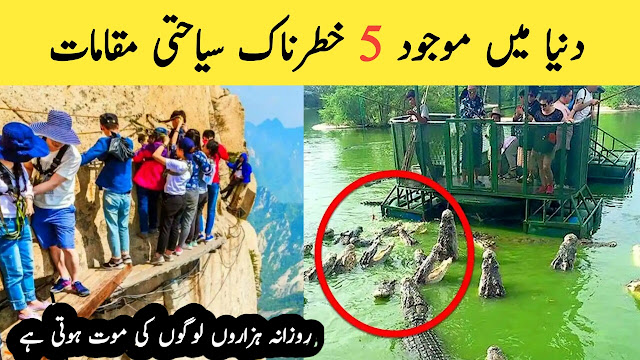Most dangerous tourist attractions in worldدنیا میں موجود 5 خطرناک سیاحتی مقامات
Hi
I Am Raheel Hussain Welcome To Our Channel Raheel Tv
1. South Loungwa national park in Africa
South Luangwa National Park is in east Zambia’s Luangwa Ri
ver valley. It’s known for its abundant wildlife. Inside the Mfuwe Gate entrance, the river is often crowded with hippos. The woodland savannah is home to hundreds of bird species. Trails from the park’s lodges wander past baobab trees, herds of elephants and rare Thornicroft’s giraffes. Spotlights are used to locate the leopard population after dark.
Area: 9,050 km²
Established: 1972
Management: Zambia Wildlife Authority
2. Mount Hua In Chaina
Mount Hua is a mountain located near the city of Huayin in Shaanxi Province, about 120 kilometres east of Xi'an. It is the western mountain of the Five Great Mountains of China and has a long history of religious significance. Wikipedia
Elevation: 2,160 m
Province: Shaanxi
3. Fish Hoek Beach in South Africa city captaon
Fish Hoek, Vissers Baay or Visch Hoek appears on the earliest maps of the Cape.
Fish Hoek beach was used on an informal basis for whaling and fishing, but it was not until 1918 that it was laid out as a township.[citation needed] Diplomat Edmund Roberts visited Fish Hoek in 1833. He described it as a "poor village" with a whaling industry.[2]
The first grant of Crown land in Fish Hoek was granted to Andries Bruins in 1818. The land was sold several times before being bought by Hester Sophia de Kock in 1883. She was then a spinster of 51 years old. In 1901, late in life, she married a local farmer, one Jacob Isaac de Villiers, who came to live with her on the farm. Although she farmed wheat and vegetables, she started providing accommodation for people who wanted to stay in Fish Hoek, and so became the first local tourist entrepreneur. Having realized that Fish Hoek was becoming popular, she left instructions in her will that the farm was to be surveyed and the land sold as building plots.
After the deaths of Hester and Jacob, the land was sold off, the first sale taking place in 1918. The oldest house on the bay, now named Uitkyk, was bought as a fisherman's cottage in 1918 by the Mossop family of Mossop Leathers, and is still in the Mossop family. There had been a building on that site since the 1690s; a poshuis or post house and a whaling station office is all that is known of its history.
4. Villarica volcano
Villarrica is one of Chile's most active volcanoes, rising above the lake and town of the same name, 750 km south of Santiago. It is also known as Rucapillán, a Mapuche word meaning "devil's house". Wikipedia
Last eruption: March 3, 2015
Elevation: 2,847 m
5. Gouffre Burger Cave France
The Gouffre Berger is a French cave discovered on 24 May 1953 by Joseph Berger, Bouvet, Ruiz de Arcaute and Marc Jouffray. From 1953 to 1963, it was regarded as the deepest cave in the world at −1,122 metres, relinquishing this title to the previous contender, Pierre Saint Martin, in 1964, after further exploration. Wikipedia
Geology: Limestone
Discovery: 1953

